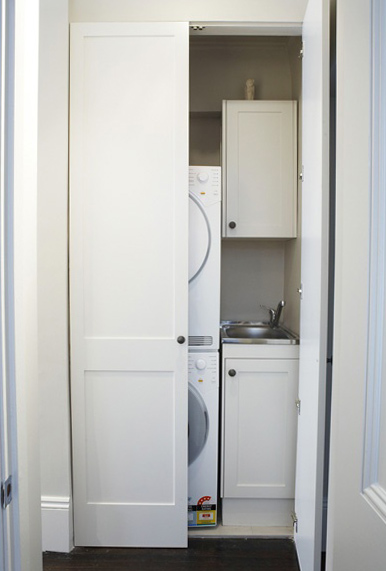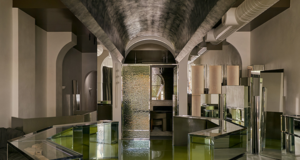
There’s plenty of debate about what the term ‘European laundry’ actually means. Find out what to expect – and how best to plan a European laundry.

‘European laundry’ is one of those popular terms that’s wide open to interpretation and a lot of pointless debate, depending on where in Europe you’ve been lucky enough to travel, and how much of a cheerful, positive spin your real estate agent or builder is trying to put on a house.
In fact, from what we’ve managed to gather, these days the term seems to be used for any kind of laundry that isn’t a standard, dedicated laundry room.
In the name of common sense, we’re defining it thusly (and hoping it catches on): a European laundry is a laundry that’s tucked away inside a cupboard, typically hidden behind either bifold doors, or pocket doors that disappear into the wall cavity.
Some people also refer to this as a ‘hidden laundry’, just to add to the chaos…
Other types of European laundries
Other interpretations which also pop up with some regularity include:
- the common British version, which incorporates washing machines and dryers into the kitchen (most houses in Australia just aren’t that hard up for space)
- versions where the washer and dryer sit in the bathroom
- versions where the laundry’s incorporated into a kind of multi-purpose mudroom (popular in bigger houses)
These all make sense – and the first two do have their practical advantages when you consider how efficiently they allow you to combine plumbing piping. But having your laundry appliances out in the open or sharing kitchen/bathroom/laundry sinks is certainly not as tidy or practical a solution as having a full all-in-one laundry-in-a-cupboard though (regardless of where it’s installed). Just finding a place for your appliances inside the bathroom or kitchen is likely to be a bit of a mess.
Given how loosely the term ‘European laundry’ is used, if you read that a house or apartment has one, it’s always worth taking a look to clarify precisely what that’s supposed to mean.
What are the advantages of a hidden / European laundry?
The biggest advantage by far to a European laundry (i.e. one in a cupboard) is the space it doesn’t require. If you don’t have room for a full, dedicated laundry room, a European laundry lets you ‘borrow’ some work space from a different area – often from a hallway, or a kitchen or bathroom if that’s where it’s hidden.
Laundries generally need a little clearance in front of washing machines and dryers. ‘Borrowing’ this space for the short amounts of time required to do your laundry makes a lot of sense – particularly if you don’t have a big family or a demanding laundry schedule.
These hidden laundries are most popular by far in flats and apartments where efficient planning of space really counts. Australia has, on average, the biggest houses in the world – chances are if you’re building a new house, you’ll have all the room you need for a dedicated, full-sized laundry room.
What does a European laundry normally contain?
If you’re planning on designing a hidden-style European laundry, try not to do away with anything you might otherwise have in a conventional laundry just to save space if that’s possible. The idea’s really to design efficiently, not to save space by doing without (that’s something you’ll regret). At the very least, your laundry should have space for:
- A washing machine
- A dryer
- Some storage space
- A laundry tub (n.b. some don’t – but this makes a big difference)
Ideally, it will also incorporate:
- A broom closet
- Space for an ironing board
- Some bench space
- A full linen cupboard / drawers
Design features and tips for European laundries
- Use solid or soundproofed doors to reduce the amount of noise from your washer or dryer
- Consider extra insulation to internal walls around European laundries to keep the noise down
- Situate your laundry near a powder room, kitchen or bathroom to minimise plumbing
- Mount washers and dryers on top of each other using wall brackets, to make the most of vertical space
- If you have a front loading washing machine, consider elevating it slightly to allow for easier loading
- If you do elevate your washing machine, leave space below to store a laundry basket
- Consider fold-out or slide-out ironing boards or benches
- Incorporate full-length drawers where possible to help make the most of storage space
- Ensure that the laundry is very well lit – install task lighting directly above work areas
- Use bright lighting and cool globe temperatures so that you can properly see colours and stains
- Consider lights that turn on automatically when doors are opened





